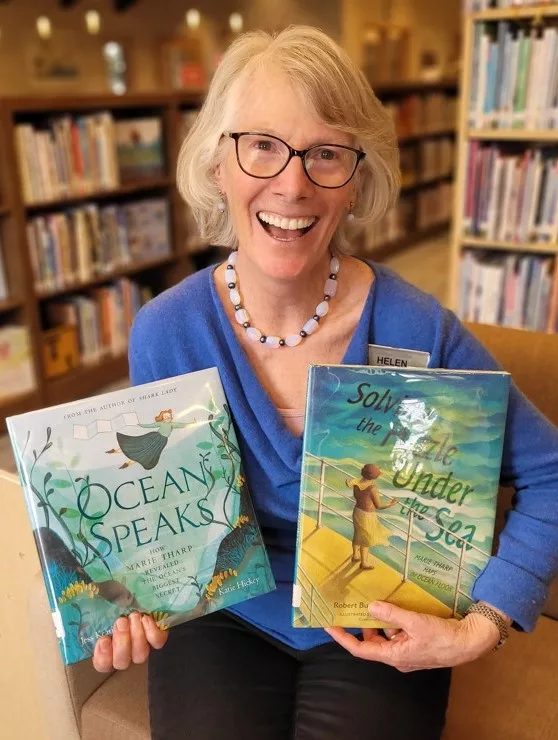Children’s Librarian Helen Morgus recommends Ocean Speaks and Solving the Puzzle Under the Sea, both about oceanographer Marie Tharp.

March is Women’s History Month. As always, I am directing my cherished reader to the Children’s (Juvenile) Nonfiction section where you can delve as deeply or as superficially as you wish into any subject that pleases you. If you’re tuned in to Women’s History Month, you will find the famous well represented in our Biography section: from Cleopatra to Amelia Earhart to Sacagawea, and so many more.
But what about the women whose names we don’t know as well? You’ll find many undiscovered treasures on the Biography shelves. And surprise! More gems are tucked into the sections where the women made their contributions to history—civil rights, sports, the arts, cooking, the sciences, etc. One of my favorite subjects of two beautifully illustrated books is Marie Tharp.
Ocean Speaks, by Jess Keating, is found in the biographies section (J 92 THA). In lyrical prose, Keating tells the story of this woman who mapped the mid-Atlantic ridge in the 1940s and 50s, a discovery that led to the acceptance of the theory of continental drift, which frames geological research today. In Keating’s telling, Tharp immersed herself in an ocean of paper and ink, a substitute for immersion in work at sea. Even in the mid-twentieth century, her male colleagues were afflicted with superstition: women were bad luck at sea. Katie Hickey’s watercolor and pencil illustrations add a dreamlike quality to Keating’s narrative, and contrast Tharp’s spunky character with her male colleagues’ stuffy demeanors.
Tharp immersed herself in an ocean of paper and ink, a substitute for immersion in work at sea. Even in the mid-twentieth century, her male colleagues were afflicted with superstition: women were bad luck on a ship.
Solving the Puzzle Under the Sea, by Robert Burleigh, is found next to the other books about earth science (J 526.09 BUR). Burleigh chooses to tell Tharp’s story in first person, bringing out more of Tharp’s internal life: her determination and her profound curiosity, as well as her sense of justice. Throughout the story, Tharp questions the lopsided, male-dominated system of making science, and in the end emerges triumphant. Tharp’s lifelong fascination with maps, her methods and data, play a larger part in this telling than in Keating’s, and Raúl Colón’s beautifully textured watercolor and pencil drawings are more precise and representational than Katie Hickey’s.
Both books make great read-alouds to children in grade school. The illustrations will help keep the younger child interested, while a curious fourth or fifth grader will enjoy the depth of the back matter, and may go on to suggested further reading. And an adult who gets hooked on Marie Tharp can check out Soundings: The Story of the Remarkable Woman Who Mapped the Ocean Floor, by Hali Felt, from the main collection (526.092 FEL).
And dear reader, PLEASE AND ESPECIALLY, read these books to your boys AND to your girls. Too much of children’s literature is trending toward “girls” books” and “boys’ books.” These books help break down those stereotypes, for everyone’s benefit.
If your pump is primed, here are more favorites about unsung women, all with wonderful illustrations and satisfying auxiliary material, found outside the Biography section. Wishing you delight and sparks of curiosity in your reading, this Women’s History Month!
- Alice Roosevelt: What to do about Alice (J 973.9 KER)
- Couture designer Anne Lowe: Only the Best (J 746.9 MES)
- Ruth Wakefield, inventor of the toll house cookie: How the Cookie Crumbled (J 641.5 FOR)
- Mary Anning, paleontologist: Dinosaur Lady (J 560.92 SKE; also available in ebook)
- Grace Hopper, Queen of Computer Code (J 359 WAL)
- Georgia Gilmore, civil rights activist: Pies From Nowhere (J 323 ROM)
- Ria Thundercloud, native American dancer: Finding My Dance (J 792.8 THU)
- Eugenie Clark, ichthyologist: Shark Lady (J 597.3 KEA; also available in eaudiobook)
